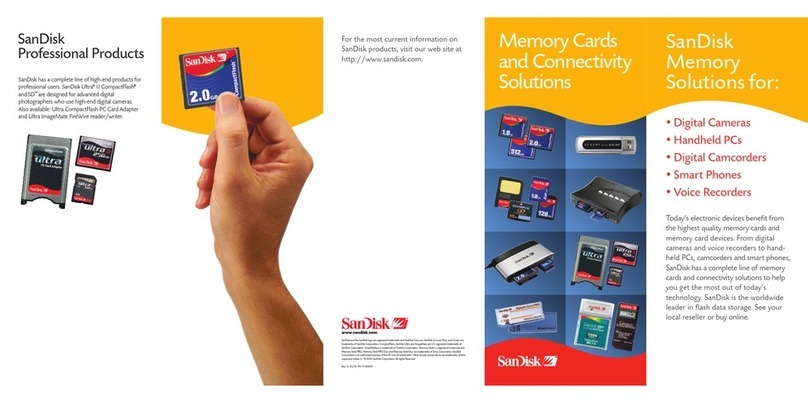
SanDisk CompactFlash Card OEM Product Manual
SanDisk® Corporation general policy does not recommend the use of its products in life support applications where in a failure
or malfunction of the product may directly threaten life or injury. Per SanDisk Terms and Conditions of Sale, the user of SanDisk
products in life support applications assumes all risk of such use and indemnifies SanDisk against all damages. Security
safeguards, by their nature, are capable of circumvention. SanDisk cannot, and does not, guarantee that data will not be
accessed by unauthorized persons, and SanDisk disclaims any warranties to that effect to the fullest extent permitted by law.
This document is for information use only and is subject to change without prior notice. SanDisk Corporation assumes no
responsibility for any errors that may appear in this document, nor for incidental or consequential damages resulting from the
furnishing, performance or use of this material. No part of this document may be reproduced, transmitted, transcribed, stored in
a retrievable manner or translated into any language or computer language, in any form or by any means, electronic,
mechanical, magnetic, optical, chemical, manual or otherwise, without the prior written consent of an officer of SanDisk
Corporation.
All parts of the SanDisk documentation are protected by copyright law and all rights are reserved.
SanDisk and the SanDisk logo are trademarks of SanDisk Corporation, registered in the United States and other countries.
CompactFlash is a U.S. registered trademark of SanDisk Corporation.
Product names mentioned herein are for identification purposes only and may be trademarks and/or registered trademarks of
their respective companies.
© 2007 SanDisk Corporation. All rights reserved.
SanDisk products are covered or licensed under one or more of the following U.S. Patent Nos. 5,070,032; 5,095,344; 5,168,465;
5,172,338; 5,198,380; 5,200,959; 5,268,318; 5,268,870; 5,272,669; 5,418,752; 5,602,987. Other U.S. and foreign patents
awarded and pending.
Document 20-10-00038 Rev. 12.0
Revision History
Date Revision Description
February 2007 12.0 Merged CFlash 11.2 manual with CF ExtremeIII
v1.2 to create v12.0; updated to comply with CFA
Spec v4.0.
© 2007 SanDisk Corporation i Rev. 12.0, 02/07




























